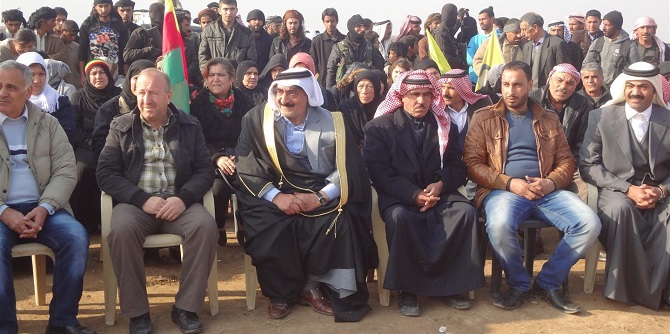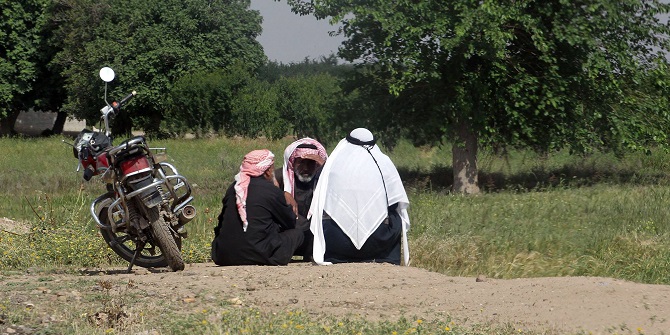Dr Haian Dukhan is the author of “State and Tribes in Syria: Informal Alliances and Conflict Patterns”(Routledge, 2019). He currently teaches politics and international relations at the University of Leicester. This blog article is a summary of Dr. Dukhan’s presentation in the ‘Political Economy and Governance in Syria’ Conference at LSE.

A council of condolences for Al Sanadid fighters who were killed during clashes with ISIS. Al Sanadid are a tribal militia composed of members of the Shammar tribe who operate under the umbrella of the Syria Democratic Forces (SDF). Source: Ronahi.
Since the start of the Arab uprisings, the role of urban versus rural populations in igniting and leading the uprisings has persistently been the subject of debate and contention. Within the SWANA region, Syria has been the first to experience an overwhelmingly rural uprising. The affluent cities of Damascus and Aleppo did not play a major role in the uprising, at least not initially. Syria’s countryside has been widely populated by tribal communities; a large part of which were displaced from their villages in the city outskirts due to the 2007 drought.
At the onset of protests, tribes played a substantial role in mobilising their communities to protest against the regime. As peaceful protests transformed into violent confrontations, many attempts were made by both the regime and opposition to win over and co-opt tribes to instrumentalise them politically and militarily.1 With the shift to a full-scale civil war, almost all armed actors from armed opposition groups (AOGs) to Islamist formations, Kurdish forces and the regime’s military and para-military factions tried to capitalise on their relations with tribes to serve their own interests.
I will attempt in this short piece to provide a critical analysis of local, regional and international efforts to co-opt the tribes in Syria, while arguing that local attempts have generally been more successful in co-opting tribes than those by regional and international powers such as Turkey, Jordan, Saudi Arabia and the USA. This might have to do with the fact that local forces and structures are more aware of localised realities and histories, especially when it comes to the changes that tribal structures have gone through in the past few decades.
This blog defines “co-optation” as the use of formal and informal mechanisms by particular authorities in their attempts to strategically draw groups towards themselves. To help delineate such a theoretical postulation, I outline different forms of co-optation2, which include the following:
- Structural co-optation: this includes widening participation in such a way that allows strategic groups to partake in governmental decisions. An example of this is the establishment of the Raqqa Civilian Council (RCC) by the Syrian Democratic Forces (SDF) to diffuse the perception of the SDF as a Kurdish force that occupies an Arab- majority governorate. Thus, the RCC’s co-chairs were Mahmoud Shawakh al-Bursan, an Arab tribal sheikh, and Leila al Mustafa, a Kurdish civil engineer. The RCC includes 20 local tribal representatives who were interested in attempting to foster social cohesion as well as thwart any attempted retaliatory acts against those thought to be associated with IS.
- Traditional co-optation: under this framework, traditional leaders of strategic groups are approached as a means of co-opting the whole group(s). An example is IS’s attempts to force and/ or convince traditional leaders to publicly pledge allegiance to them.
- Identity-based co-optation: this includes the creation, revival and manipulation of religious, ethnic and tribal networks to mobilise the community, where the ruling authorities become the centre of patronage and loyalty. For instance, Hafez Al-Assad’s attempts to manipulate and revive the tribal identity as a means of stabilising the regime.
- Material co-optation: which all actors use. Here, different authorities grant financial benefits to the groups that they want to co-opt.
History of co-optation under Ba’ath party rule
Tribal power and authority were severely diminished by the pervasiveness of nationalist and socialist discourses following Syria’s independence. However, upon Hafez al- Assad’s assumption of power in the 1970s, the regime established networks of patronage with influential tribal leaders. The latter’s pledge of loyalty to the regime was reciprocated with wider local authority.
A series of incentivising measures were thus put forth in order to absorb tribes into the state structure. State policies and subsidies favoured tribal leaders, thereby creating tribal social support for the regime that could be, and often was, used in conflicts with other societal segments, such as the Kurds and Islamists. These practices and policies were reflected in an increase of tribal representation in the al-Ba’ath party, the Syrian army and security apparatuses, as well as in parliament.
This is an epitomic example of structural co-optation. However, two vital factors need to be considered here. First, the Syrian regime did not co-opt tribes in their existing hierarchies and structures but rather “created a new class structure by dismantling the power of the tribes from inside out… the regime side-lined traditional tribal sheikhs and replaced them with people associated with the intelligence services”, according to Sheikh Nawef al-Bashir. Thus, the sheikhs’ roles, positions, and powers within their own tribes changed and were often diminished. Second, a weakening of kinship ties, resulting from factors such as education, physical mobility, settlement and urbanisation, amplified tribes’ susceptibility to being co-opted.
An increase in education within tribal ranks led to the emergence of a young educated class who were generally more cynical of the authority of traditional sheikhs. This led to major intra-tribal divisions between modernists and traditionalists. At this stage, namely between the 1970s and 2000, tribal divisions had no significant impact on the regime. The regime continued to co-opt large numbers of tribal members, particularly from Deir Ez-Zour and Hauran, into party leadership, government institutions and popular organisations such as the peasants’ union.
When Bashar al-Assad assumed power, he continued the same co-optation policy in order to secure the regime’s survival. However, following the US invasion of Iraq, co- optation came to hold another function. Bashar al-Assad delivered an unusual speech in Deir Ez-Zour praising tribal history and the tribes’ national struggle against the French occupation. The speech was part of a larger attempt to encourage large numbers of tribal youth to fight in Iraq, an initiative that would later garner political leverage for the regime on the international arena. As an incentive, the regime granted financial rewards for tribal leaders, as well as governmental employment opportunities for their children and relatives. This is somewhat similar to the regime’s use of tribal connections, albeit on a regional level, to suppress the Kurdish revolt of al-Hassakeh in 2004.
However, Bashar al-Assad’s policies of economic liberalisation disproportionately benefitted urban populations, particularly the major cities, while neglecting rural areas. Under him, the party apparatus and workers’ and peasants’ unions were regarded as obstacles to economic reform. Therefore, a large segment of their governmental funding was withdrawn.
IS attempts to co-opt Syrian tribes
The contraction of state services to rural areas culminated in the increased impoverishment, marginalisation and frustration of rural populations, particularly tribal youths. However, tribal leaders still enjoyed special privileges and influence under al- Assad’s rule and were also able to benefit from his neo-liberal policies. This effectively led to the creation of an affluent clientelist class within tribal structures themselves, locally coined as Awlad al-Sulta (or “progenies of the authority”), who were largely alienated from the rest of their tribes. Coupled with stark intra- tribal class discrepancies, contraction in state services to rural areas created a level of grievance and lethargy in intra- and inter-tribal bonds that allowed for Islamist groups to capitalise on this social cleavage. During the early stages of the uprising, tribal youths took to the streets not only to protest against the regime’s unrestrained and atrocious exercise of authority, but also that of traditional sheikhs.
While there is a wide retreat of IS from rural tribal areas, information indicates that IS might resurge in the eastern part of the country. Therefore, it is relevant to provide a critical analysis of IS’s co-optation strategy.
Since 2013, IS has come to control large swathes of eastern Syria. Consecutive videos have subsequently emerged of tribal leaders publicising their allegiance and loyalty to IS. Similarly, IS also incentivised tribes by granting them wider margins of local authority. Traditional sheikhs were responsible for collecting taxes (Zakah in Islamic jurisprudence) within their localities, communal arbitration, civil documentation, and registering families in need of assistance. In return, those sheikhs were granted access to regional IS meetings, which brought together representatives from each region controlled by IS, and were also provided with bribes and endowments.
The SDF succeeds in its co-optation attempts

Following the International Coalition’s alliance with Yekineyén Parastina Gel (YPG), the latter approached Arab tribes to construct the SDF, a united force against IS. Under this umbrella group, YPG and Yekineyén Parastina Jin (YPJ) forces merged with tribe-based Arab militias. Later, the SDF itself widened the coalition to include the tribes of Ar-Raqqa in order to liberate the city and governorate. Once Ar-Raqqa was taken over by the SDF, a series of meetings with tribal sheikhs led to the creation of an administrative body called the Raqqa Civilian Council. It might be argued that SDF has been the most successful in co-opting tribes. Several young members of local tribes were provided with employment opportunities within the Raqqa Civilian Council.
Turkey also organised meetings with tribal sheikhs in the south in attempts to mobilise them against Kurdish military forces. As a result, several tribal leaders publicly announced their support for Turkey’s “Olive Branch’ military operation against Afrin. Although a full invasion of Raqqa seems unlikely, in part due to US opposition, Turkey still connects with Raqqa’s tribes to cause tension and unrest in the governorate.
The current status of tribes
Bashar al-Assad instigates tribes to pressure the SDF to hand over the Raqqa governorate to the regime. Co- optation still happens along the lines delineated earlier while manipulation of internal power dynamics within tribal structures subsists, as a means of co-optation, just as it has been used since al-Ba‘ath’s takeover of power. Tribes are an essential force for the regime to retain areas controlled in the east of Syria.
Since tribes are mobilised and co-opted by several of the warring factions in Syria, there is a risk of positing them against each other in a future battle. A US withdrawal of support from the SDF would increase that likelihood and open the possibility of inter-tribal confrontations over Syria’s eastern parts.
To conclude, one of the most visible analytical outcomes of this research is that local forces and groups are noticeably more successful in co-opting Syria’s tribes than external powers. This is mainly due to the fact that external powers’ knowledge and understanding of tribal structures and their history hampers their ability to construct long- lasting alliances.
1 For more details about the role of the tribes in the Syrian uprising, read Haian Dukhan’s book: State and Tribes in Syria: Informal Alliances and Conflict Patterns. (Routledge, 2019).
2 This paper relies on the theoretical work of Maria Josua who disaggregated co-optation strategies into different realms. Josua, M., 2011. Co-optation as a Strategy of Authoritarian Legitimation. Success and Failure in the Arab World. University of Tübingen, Germany, Institute of Political Science, Research Unit on Middle East and Comparative Politics.
Note: The CRP blogs gives the views of the author, not the position of the Conflict Research Programme, the London School of Economics and Political Science, or the UK Government.





2 Comments